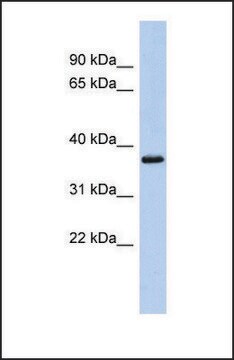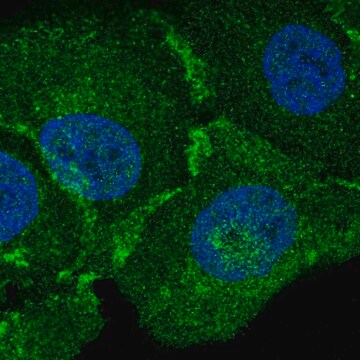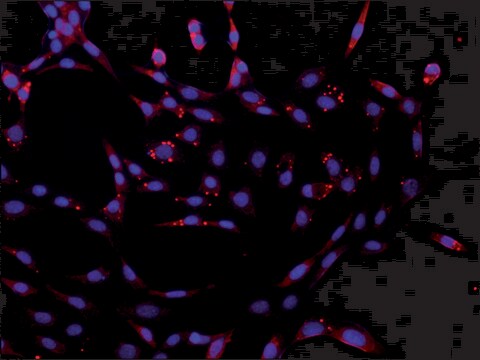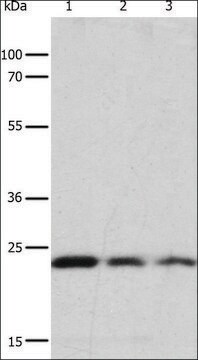추천 제품
생물학적 소스
rabbit
결합
unconjugated
항체 형태
affinity isolated antibody
항체 생산 유형
primary antibodies
클론
polyclonal
양식
buffered aqueous solution
분자량
antigen ~150 kDa
종 반응성
human
농도
~1.0 mg/mL
기술
immunoprecipitation (IP): 5-10 μg using ysates of HEK-293 cells over expressing human EDC4
indirect immunofluorescence: 2-5 μg/mL using paraformaldehyde fixed NIH-3T3 cells over expressing human EDC4
western blot: 0.5-1 μg/mL using lysates of HEK-293 cells over expressing human EDC4
UniProt 수납 번호
배송 상태
dry ice
저장 온도
−20°C
타겟 번역 후 변형
unmodified
유전자 정보
human ... EDC4(23644)
mouse ... Edc4(234699)
rat ... Edc4(361399)
일반 설명
Enhancer of mRNA-decapping protein 4 (EDC4), also known as human enhancer of decapping large subunit (HEDLS) or Ge-1, is characterized with an N-terminal WD40 repeat and a C-terminal domain which interacts with mRNA-decapping enzyme subunit 2 (Dcp2), and mediates EDC4 oligomerization and P-body localization .
The EDC4 gene maps on human chromosome 16q22.1.
특이성
Anti-EDC4 (N-terminal) specifically recognizes human EDC4.
애플리케이션
Anti-EDC4 (N-terminal) antibody has been used in:
- immunoprecipitation
- immunofluorescence
- immunoblotting.
생화학적/생리학적 작용
Human enhancer of mRNA-decapping protein 4 (EDC4) associates with hDcp2 and stimulates hDcp2 activity in vitro as well as mediating the interaction between mRNA-decapping enzyme subunit 1 & 2 (DCP1 and DCP2).
Interaction of processing-body components, EDC4 and Dcp1a is essential for the post-transcriptional regulation of interleukin (IL)-6.
물리적 형태
Solution in 0.01 M phosphate buffered saline, pH 7.4, containing 15 mM sodium azide.
저장 및 안정성
Store at –20 °C. For continuous use, the product may be stored at 2–8 °C for up to one month. For extended storage, freeze in working aliquots at –20 °C. Repeated freezing and thawing is not recommended. Storage in “frost-free” freezers is also not recommended. If slight turbidity occurs upon prolonged storage, clarify the solution by centrifugation before use. Working dilutions should be discarded if not used within 12 hours.
면책조항
Unless otherwise stated in our catalog or other company documentation accompanying the product(s), our products are intended for research use only and are not to be used for any other purpose, which includes but is not limited to, unauthorized commercial uses, in vitro diagnostic uses, ex vivo or in vivo therapeutic uses or any type of consumption or application to humans or animals.
적합한 제품을 찾을 수 없으신가요?
당사의 제품 선택기 도구.을(를) 시도해 보세요.
Storage Class Code
10 - Combustible liquids
Flash Point (°F)
Not applicable
Flash Point (°C)
Not applicable
가장 최신 버전 중 하나를 선택하세요:
A human microprotein that interacts with the mRNA decapping complex
D'Lima N G, et al.
Nature Chemical Biology, 13(2), 174-174 (2017)
Target-specific requirements for enhancers of decapping in miRNA-mediated gene silencing
Eulalio A, et al.
Genes & Development, 21(20), 2558-2570 (2007)
Jucimara Colombo et al.
Oncology reports, 21(3), 649-663 (2009-02-13)
Laryngeal squamous cell carcinoma is very common in head and neck cancer, with high mortality rates and poor prognosis. In this study, we compared expression profiles of clinical samples from 13 larynx tumors and 10 non-neoplastic larynx tissues using a
Nadia G D'Lima et al.
Nature chemical biology, 13(2), 174-180 (2016-12-06)
Proteomic detection of non-annotated microproteins indicates the translation of hundreds of small open reading frames (smORFs) in human cells, but whether these microproteins are functional or not is unknown. Here, we report the discovery and characterization of a 7-kDa human
Martin Fenger-Grøn et al.
Molecular cell, 20(6), 905-915 (2005-12-21)
Decapping is a key step in mRNA turnover. However, the composition and regulation of the human decapping complex is poorly understood. Here, we identify three proteins that exist in complex with the decapping enzyme subunits hDcp2 and hDcp1: hEdc3, Rck/p54
자사의 과학자팀은 생명 과학, 재료 과학, 화학 합성, 크로마토그래피, 분석 및 기타 많은 영역을 포함한 모든 과학 분야에 경험이 있습니다..
고객지원팀으로 연락바랍니다.








